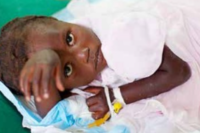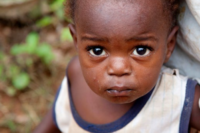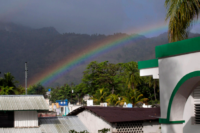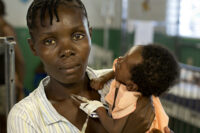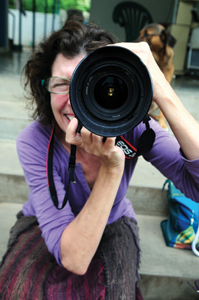 By Patti Gabriel
By Patti Gabriel
Good fortune was mine the day I met Dr. Bill Guyol at Cardinal Glennon Children’s Medical Center. I was working on a story about Woodler, a little Haitian boy being treated at Glennon. Dr. Guyol was one of several doctors responsible for bringing Woodler to St. Louis for treatment, and it was time for him to pay Woodler a visit. Dr. Guyol’s dedication and concern for this little boy was palpable. Conversation ensued, and before I knew it, he was offering me the opportunity to travel with his next medical volunteer team to Milot Haiti.
My excitement was tinged with some apprehension however, when the cholera epidemic made its way to northern Haiti, where Hôpital Sacré Coeur and the CRUDEM Foundation base are located. Treating cholera patients could wind up being the team’s only objective during our trip. I was a nonmedical volunteer, as was Jeannette Cooperman, a writer for St. Louis Magazine, and we weren’t sure what we would be asked to do once we arrived.
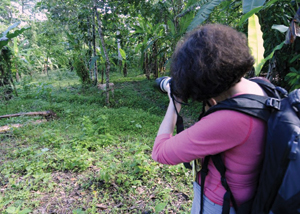 I felt that the best contribution that I could make was to photograph as much of what CRUDEM does as possible, but I really had no idea what that would entail—or if the urgent medical priorities of a deathly epidemic would make it impossible.
I felt that the best contribution that I could make was to photograph as much of what CRUDEM does as possible, but I really had no idea what that would entail—or if the urgent medical priorities of a deathly epidemic would make it impossible.
It took no time at all to feel very comfortable with our crew of volunteers. We were all rookies. Other than Dr. Guyol, none of us had been to Haiti.
Since much of my work over the years has involved photographing in medical settings, I’ve witnessed the unique sense of humor that doctors and nurses can have—and I was not disappointed.
Our St. Louis crew bonded quickly during the very busy days given the collaborative environment, with communal dining and 3 amazing meals a day, free of the mundane tug of multiple demands that all our lives require day to day at home.
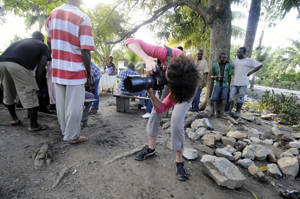 As for me, I found I could eat, sleep, and breathe photography, totally immersing myself in this single, important project. Shooting all day, learning about a world where time moves at a different pace, editing at night, to get up looking forward to whatever came my way the next day. My work was possible because Dr. Guyol paved the way for both me and Jeannette to do our work.
As for me, I found I could eat, sleep, and breathe photography, totally immersing myself in this single, important project. Shooting all day, learning about a world where time moves at a different pace, editing at night, to get up looking forward to whatever came my way the next day. My work was possible because Dr. Guyol paved the way for both me and Jeannette to do our work.
He introduced us to everyone we needed to know, gave us full access, and showed us the lay of the land. He gave us the credibility we needed and, after a day or two of wandering the campus, the staff knew why we were there and they were quite cooperative.
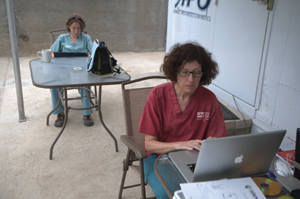 Once I’d been there a week or so, I found that when I walked down the main street of town, my eyes could meet theirs and I felt myself given the unspoken permission to enter their world for that brief time. It was a privilege. I started to appreciate how many simple things we take for granted could make a difference.
Once I’d been there a week or so, I found that when I walked down the main street of town, my eyes could meet theirs and I felt myself given the unspoken permission to enter their world for that brief time. It was a privilege. I started to appreciate how many simple things we take for granted could make a difference.
The seeming magic of a photograph, for example….shooting with a digital camera, I could almost instantly show my subjects what I shot by replaying it on the back of the camera where they could view it. With the children, this could bring loud laughter and giggles. They’d even roll on the ground with delight.
The photographs made them happy. They would make a sign that I think meant, “Okay, where is my picture”?
No one actually has photos in Haiti, and they certainly could not understand why I could not present them with a souvenir. I made up my mind that every person I photographed in Milot would get a photo when I returned. I asked one of the security guards, “Hey if I bring photos back, how will I find the people in the photos?” He said, “Oh, don’t worry, someone will see the photo, recognize the person and get word to them that it is here, and they will come to get it.”
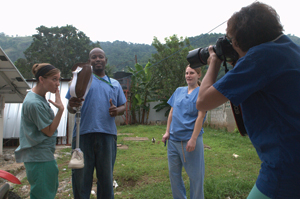 It seems a very small thing, but I suspect they will appreciate it more than I know. And I have no doubt that the guard knew what he was talking about. This is a town where there are chickens running around all over the place, and everyone knows whose chickens are theirs and who the other ones belong to!!!!
It seems a very small thing, but I suspect they will appreciate it more than I know. And I have no doubt that the guard knew what he was talking about. This is a town where there are chickens running around all over the place, and everyone knows whose chickens are theirs and who the other ones belong to!!!!
My team was leaving after a week, but I was to catch a flight out several days later. Due to complications because of the election results, the airport closed and two days turned into five. This gave me an opportunity to spend time with a new group of volunteers and Tim Traynor. Tim’s a veteran working on infrastructure improvements for the foundation and has quite a local following. I could move into the surrounding countryside with him and photograph its landscape, color, and textures.
The previous week, I had been focusing on the medical mission, volunteers, and foundation staff. Now I slowed the pace, took time to step outside that world. Tim was traveling to several villages with a group of locals to assess water conditions and teach cholera prevention. He generously let me accompany them, traveling the dirt roads by motorcycle.
I was feeling so at home with the CRUDEM staff and volunteers that I was grateful for the extra time I had there. The photography from week two is completely different from that of week one. But I want to apply the same principle of bringing photos back for all of my willing subjects. It is such a small thing to do, but I just feel it is important.
Milot is a town in large part because of Hôpital Sacré Coeur. CRUDEM is helping Milot to be sustainable, offering mentoring and training to Haitians. The people know the value of that, and they respect and trust the efforts of the staff and volunteers. They have a reason to be hopeful.
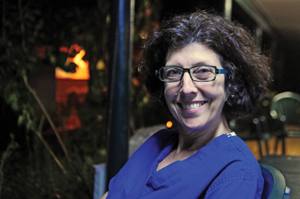 Patti Gabriel owns Patti Gabriel Photography (pattigabriel.com) in St. Louis. During her November 2010 trip to Milot, Patti captured image upon image of the evocative beauty, passion and nobility of daily life in and around the bustling Haitian hospital and generously donated the use of those photos (many in our latest Bon Nouvel magazine!) to CRUDEM.
Patti Gabriel owns Patti Gabriel Photography (pattigabriel.com) in St. Louis. During her November 2010 trip to Milot, Patti captured image upon image of the evocative beauty, passion and nobility of daily life in and around the bustling Haitian hospital and generously donated the use of those photos (many in our latest Bon Nouvel magazine!) to CRUDEM.





